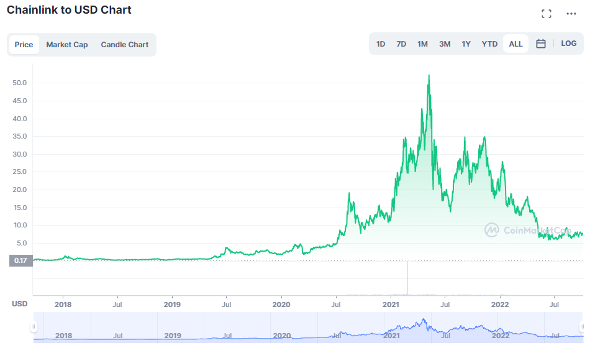While Chainlink appears out of fashion, tech improvements and its Coinbase partnership could send it to new highs in 2023.
Chainlink (LINK) was an incredibly popular altcoin in 2021, breaking into the top ten by market cap for months at a time. But even though it still boasts a $3.8 billion market cap and remains the 22nd largest cryptocurrency, it’s stayed largely under the radar in 2022.
The crypto’s use case is to ‘securely connect smart contracts with off-chain data and services.’ Specifically, it utilises ‘decentralized oracle networks provide tamper-proof inputs, outputs, and computations to support advanced smart contracts on any blockchain.’
Accordingly, Chainlink is a market leader in decentralised finance applications, as a DeFi app can use the cryptocurrency to access data about the prices of other cryptocurrencies, which is extremely useful for applications like synthetic tokens or crypto-collateralized stablecoins.
In addition, Chainlink oracles can supply verifiably random numbers to smart contracts, which makes the altcoin a key component in some blockchain-powered games and NFT collections that by necessity must include randomness in their minting process.
And encouragingly, the total value of crypto assets deposited into markets that use Chainlink oracles now exceeds $37 billion.
Chainlink: price analysis
Chainlink followed the standard pandemic-era crypto craze, striking a record $52.88 in May 2021, before collapsing to just $7.67 today. However, the coin appears to have formed a bottom over the past few months.
And multiple bullish trends point to a resurgence. Indeed, crypto trading expert Michael van de Poppe enthuses that ‘Chainlink between $6-8 is still an opportunity of a lifetime.’

To start with, former Google CEO and current billionaire Eric Schmidt believes Chainlink has ‘better technology,’ and ‘scales better’ than both Bitcoin and Ethereum. Now working as a strategic adviser to Chainlink Labs, he has also argued that government should not ‘ask for regulation too early,’ warning that Biden’s orders to increase crypto regulation could dampen innovation in the short term.
Last month, Chainlink hosted Web3 conference SmartCon, where it announced a surprise partnership with the SWIFT Network. The partnership will centre on cross-chain interoperability protocols which will enable SWIFT messages to instruct on-chain token transfers. Essentially, the idea is to accelerate the adoption of distributed ledger technology among the global banking outfits that rely on SWIFT.
The network handles trillions of dollars of payments every day, and the partnership could be far bigger news than the mass media yet realise.
SWIFT hit headlines earlier this year when multiple Russian banks were hit with a ban in retaliation for the invasion of Ukraine.

Then there’s the upcoming staking capability to consider, which allows investors to commit their Chainlink tokens in smart contracts to back certain performance guarantees around oracle services, in exchange for financial returns. This will initially take place on the Ethereum mainnet in December, with the initial staking pool containing 25 million LINK tokens, with plans to grow to 75 million over time.
The crypto project has also announced two key development initiatives: BUILD and SCALE.
BUILD gives projects the option to allocate a portion of their total token supply to Chainlink in exchange for enhanced access to premium Chainlink services.
Meanwhile, SCALE will help improve Chainlink’s economic sustainability, a key concern in the wake of Ethereum’s Merge. Projects that choose to participate in the SCALE program will help cover operating costs for Chainlink’s decentralized oracles, giving developers more affordable access to oracle services.
Moreover, Santiment analysis shows that crypto whales with addresses holding between 10,000 to 1 million LINK tokens have increased their supply by more than 3% in the past four months. Santiment argues that ‘this is quite the massive increase, and it is the highest percentage of LINK held by these addresses in exactly three years.’
But that’s not all.
Chainlink Labs is also collaborating with Coinbase, the largest US crypto exchange, to introduce NFT floor pricing feeds via its Cloud service, allowing developers to access real-time NFT prices to help create new DeFi applications like NFT lending markets.
The project works by leveraging Coinbase Cloud’s NFT pricing algorithm to scan every NFT transaction in a collection, then estimating the current floor price and updating it in real time as new transactions are recorded.
The idea is that increased price certainty will both encourage lending against NFTs as collateral, while preventing lending services from collapsing as they can price in the chance of a devaluation to the floor.
Coinbase VP of data, Michael Li, argues that ‘we’re bridging the gap between transparency and security in the NFT space by bringing reliable and timely on-chain NFT Floor Pricing Feeds for the top NFT collections to the Web3 world.’
And while the NFT space is suffering right now, the recovery could see Chainlink underpinning the auction market.
Of course, with a global recession incoming, no investment is certain.
This article has been prepared for information purposes only by Charles Archer. It does not constitute advice, and no party accepts any liability for either accuracy or for investing decisions made using the information provided.
Further, it is not intended for distribution to, or use by, any person in any country or jurisdiction where such distribution or use would be contrary to local law or regulation.
